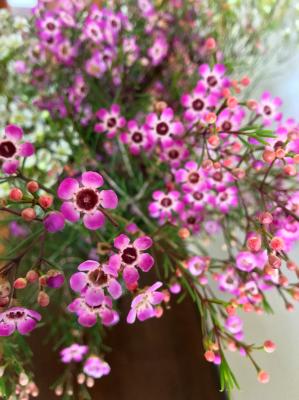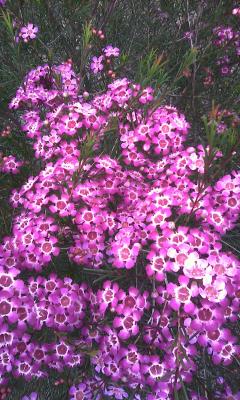I’ve been busy spreading assorted seeds over my garden and watering them in a hope that some will germinate. I am here to tell you though, that there is one thing that will not grow if you add water… in fact it will actually die!
I was very busy dealing with all sorts of things the other day and put my phone in the shade under a gardenia in a pot on my front patio.
Eventually got back to the garden and watered it all, including the gardenia, and then, muuuch later, went looking for my phone… last resort I looked on the front patio.
Well, phones do not grow or multiply when watered. They die! All is well though – I have found an old one that works and most of my things were transferred with the sim card.
As you will know I love native plants and at the moment there are a number of geraldton wax bushes in full glorious flower around town. At least two of my neighbours have them and I am surprised as I thought this area would be too cold and the soil too heavy, to accommodate them.
My wonderful mother-in-law had a Geraldton wax in her garden on a property at Narromine and my daughter has one at Boddington in WA. Both areas have very sandy soil similar to the natural growing areas of the shrub.
They are obviously fairly adaptable though to be doing so well in our area.
The botanical name is chamelaucium uncinatum with the last part meaning “hooked” in Latin and referring to the end of the leaves.
As the name would suggest they are native to the Geraldton area of WA, but similar wax flower plants can be found over much of WA and named for each area where they appear – even Esperance wax flower, so they grow over a very wide area.
As I researched them on the internet I found a company in WA that has been investigating their use as a native food. I had no idea they were edible and was pleased to learn something new to pass on to all those that read my ramblings.
The most popular variety is “Raspberry Ripple”. This has no reflection on the taste but is named for its lovely raspberry coloured flowers.
Apparently it has a strong citrus taste and can be used in many ways. The simplest seems to be as you would rosemary – simply pluck the leaves and use them for flavour.
This is something I will definitely try soon. Sounds like it would complement fish and chicken really well. Adrian Parsons, the man behind these innovations, has sent me some recipes, so will definitely try them out.
At this time it is primarily used in high end restaurants in Perth, Adelaide and Melbourne but ultimately the aim is to have the product on supermarket shelves alongside all our regular herbs and spices.
It can be used to infuse oil, dried and used as a tea and also as a freeze dried powder. Bulk quantities of leaf have been supplied to gin producers to use as a flavouring in their product. It has been used as an infused oil used in the finals of the MasterChef programme.
I like to hear of our native plants being used in innovative ways and applaud anyone who is endeavouring to promote native foods. Finger limes, lemon myrtle, quandongs and davidson plums have become relatively well known and I have frequently used products from the Outback Spirit range available in the supermarket and love the flavours.
The shrub grows to about 2.5 metres high and wide in full sun and preferably sandy, well drained, soil but can handle heavier soil so long as it is well drained. They flower from June to November in shades from white through to pink and, as with Raspberry Ripple, they have been bred to produce beautiful deep pink to red and even purple blooms.
As they are doing well in Warwick, they obviously can tolerate some frost. A light prune of spent flowers will keep them looking good but they don’t like being cut back hard.
They have few pests or diseases so long as they have plenty of sun and good drainage. If they don’t have good drainage they can develop root rot and will be short lived. Lack of sun and they can develop scale.
They go well with other natives such as grevilleas, banksias, correas and westringia. They have a lovely perfume and are very attractive to native birds, bees and butterflies. At present grevilleas are flowering well in town and also supplying colour and nectar for our birds.
There are dwarf varieties that have been bred to do well in pots and these are very popular as decorator plants in Japan and other Asian countries.
As a result of my reading I think I will definitely have to find a spot in my garden for one.








